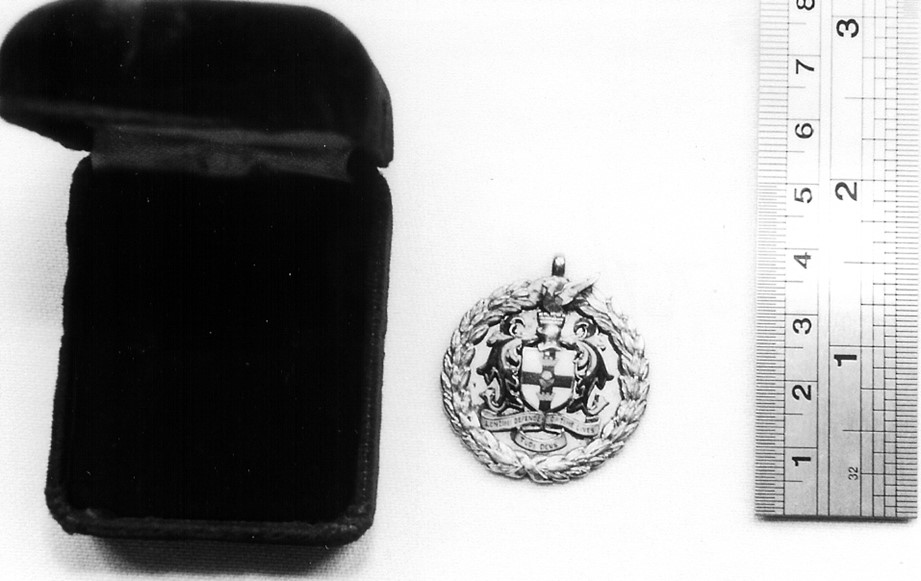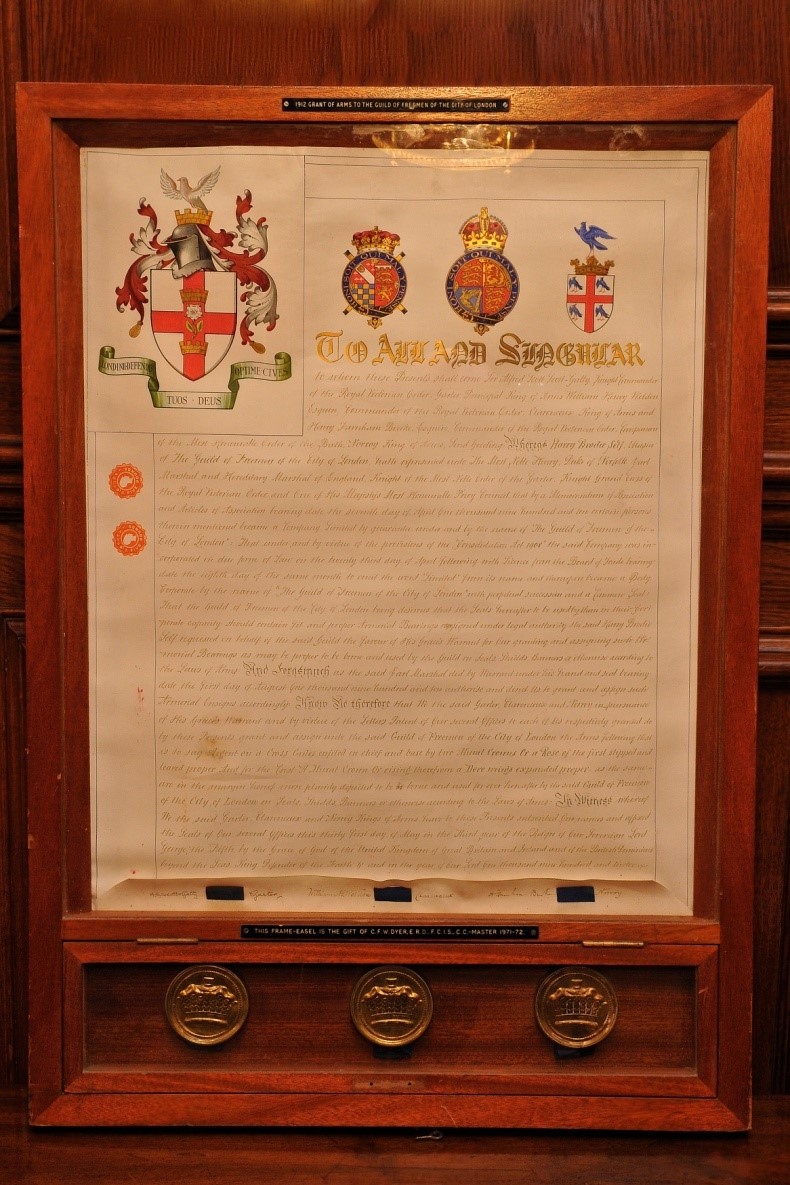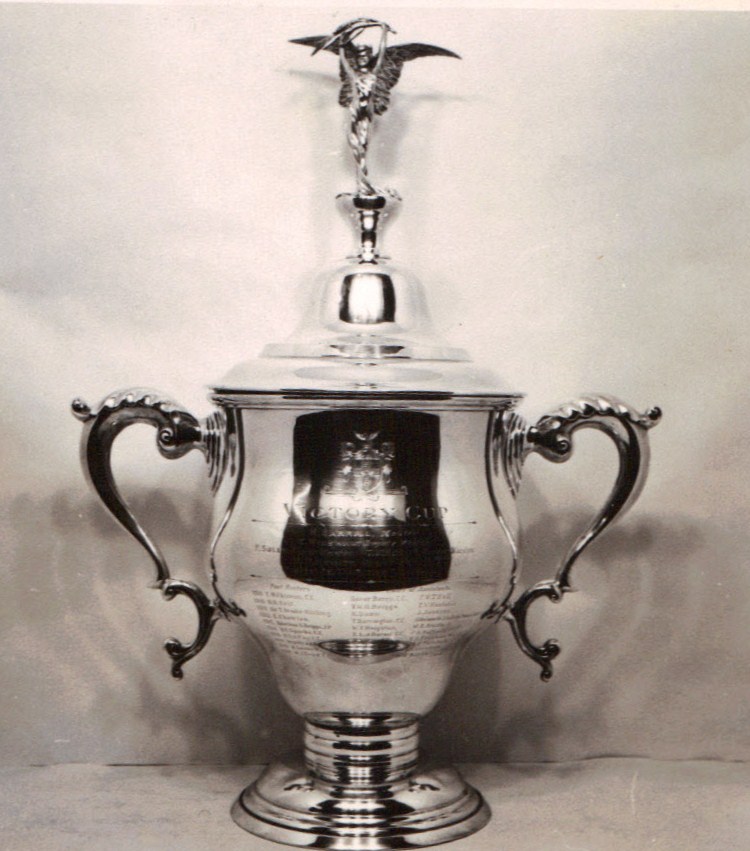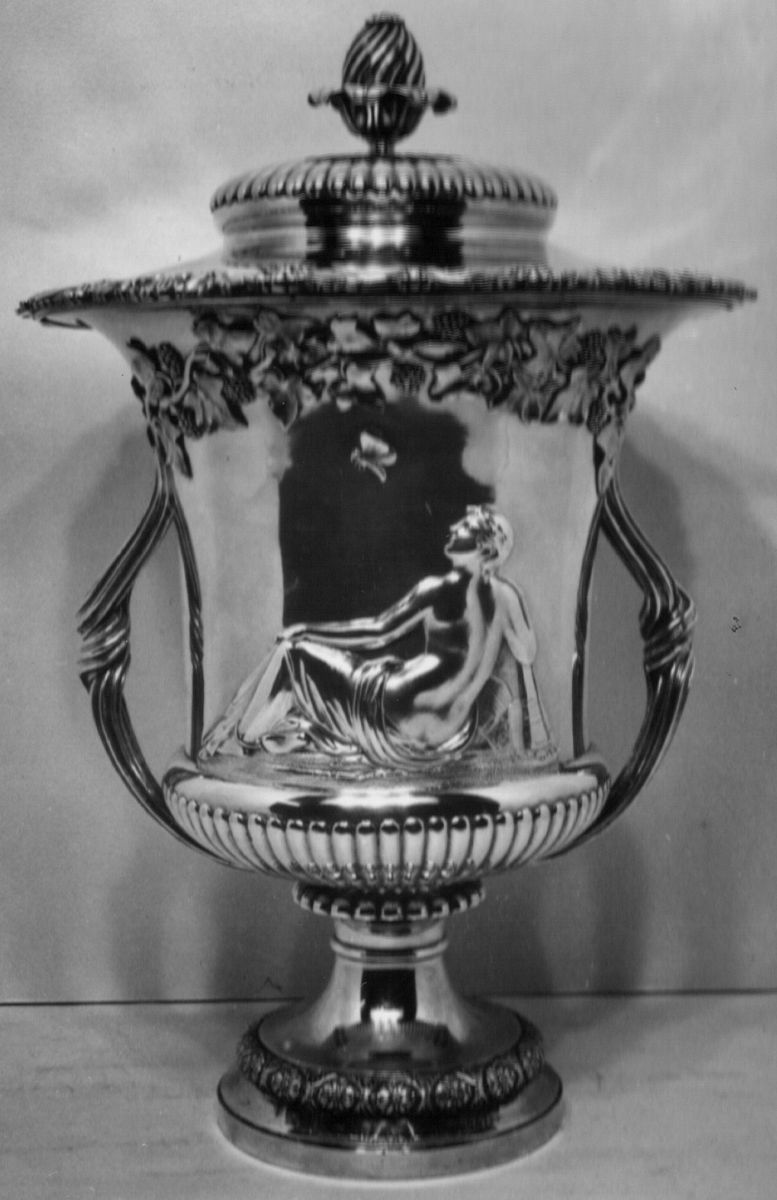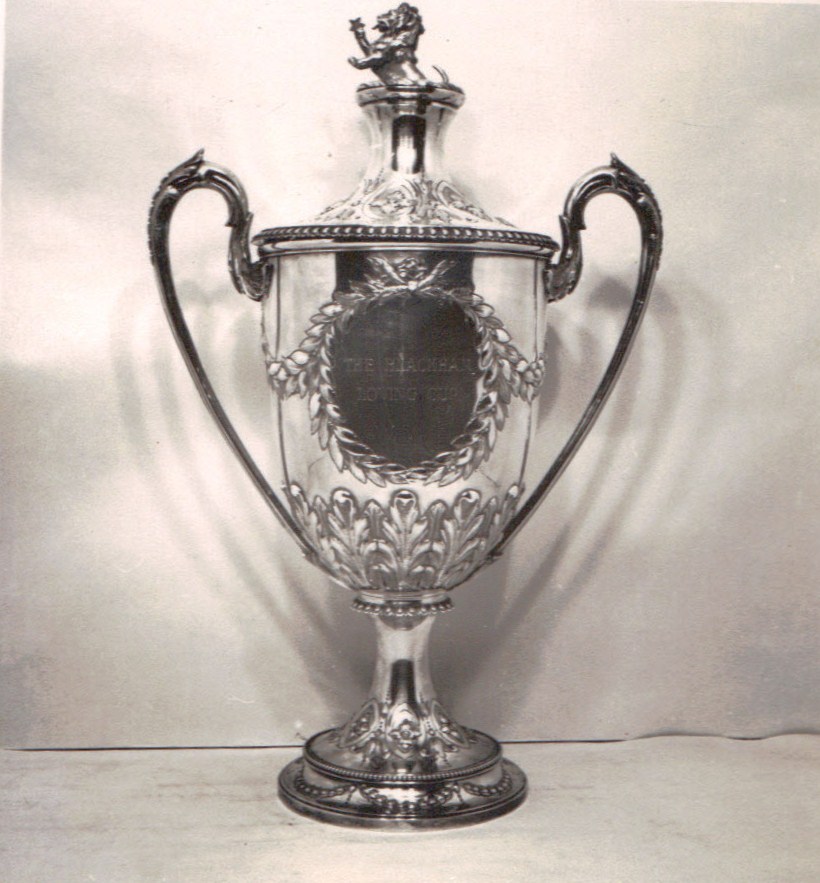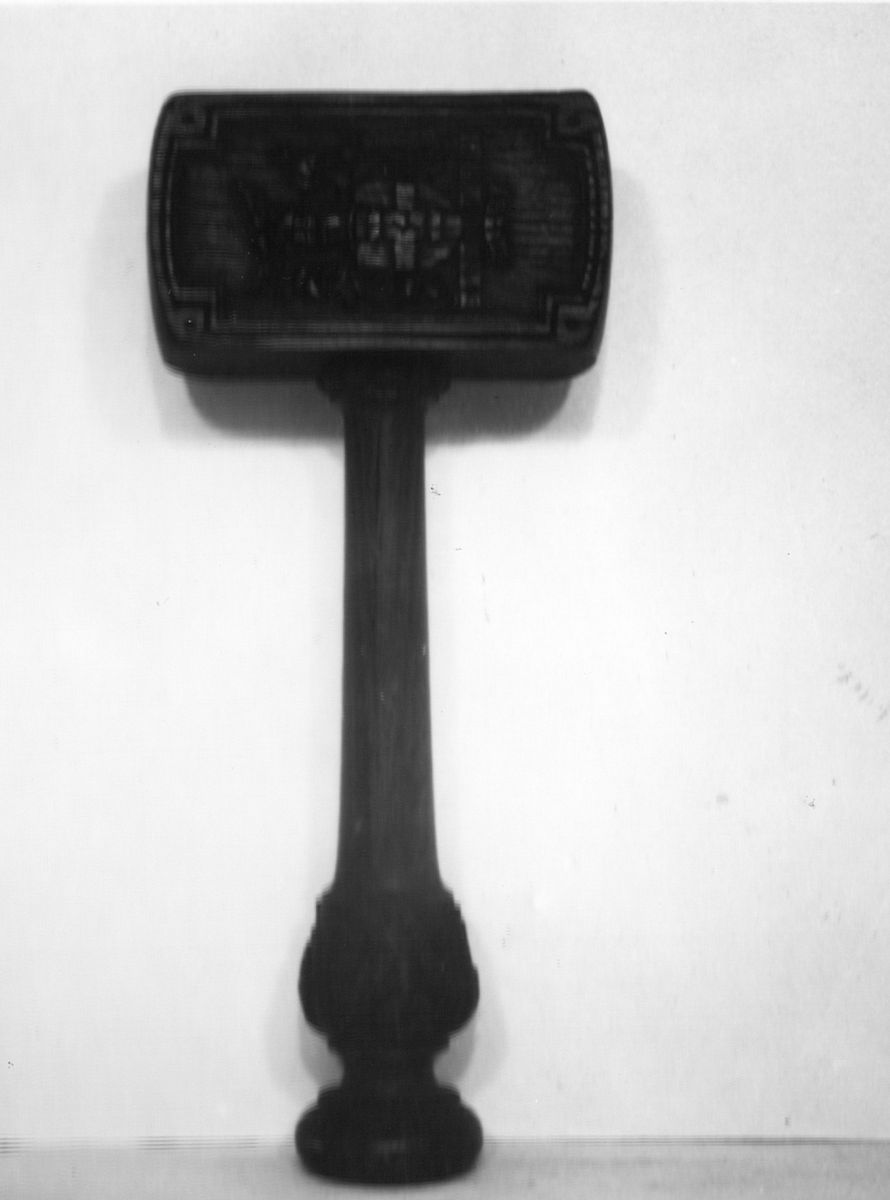The Guild has a collection of silver and artefacts which has been made possible by the generosity of Past Masters, Guild members and associations that the Guild has links with.
Below is an article by Guild Member Sheldon Shapiro, a second generation antiques dealer and Owner of Shapiro & Co in Mayfair
The Guild of Freemen of the City of London
A journey through history highlighting some of the Guild’s treasures
Lets start with a little history lesson!
The Freemen of the City of London retains its inception under the Royal Charter of Henry I from as early as 1120.
London is a very interesting City in the fact that it consists of an area of 677 acres or just about a square mile, a size that has remained unchanged for a thousand years.
In these early times London meant the City of London which consisted of 25 wards, originally of self-governing areas in which the first guilds and fraternities were formed, and the right of freemen of the City of London was such that no one was permitted trade either as a Craftsman or Merchant unless admitted to the Freedom of the City.
Those that held the freedom, had valuable rights administered by the Corporation of London a governing body, and of course control of this Corporation was in the hands of its citizens, which has remained unchanged until today.
Originally all freemen of the City of London were members of livery companies, but in 1834 new laws were passed allowing freemen to exist as a separate entity and the freedom of the City of London became available by direct application
Formation of the Guild
The Guild of Freemen of the City of London was first suggested in a letter from George Chambers, a Freemen of the City that was posted in November 1907 to the City Press; the leading and oldest newspaper of the City of London.
Many other letters followed by fellow Freemen and friends, Bernard J Smythe, James Arthur Cannon, William Smith, Harry Brodie Self and William Witt; gentlemen who would become founding members of the Guild of Freemen of the City of London.
On the 13th of July 1908 James Arthur Cannon called a meeting at his house in Forest Hill, and with Smythe, Smith and Witt, brought forward the idea of forming a Guild of the Freemen of the City of London.
The City Press reported that meeting with great detail and Mr Cannon called another meeting on the 29th of July at the City Arms Free Tavern at 2 St Mary Axe in the Ward of Aldgate which led to the creation of the Guild of Freemen; and after great discussion and deliberation, and probably after many glasses of ale, it was agreed that Cuthbert Wilkinson CC, a Freeman of the City and proprietor of a printing and publishing business in East Harding Street in the Ward of Farringdon Without, would become the first Master of the Guild of Freemen of the City of London in 1909.
Later on, that year, the first formal meeting of the Guild of Freemen would be held at Ewell Court in Surrey, the weekend retreat of Cuthbert Wilkinson, and in the following year on the 23rd of April 1910 on St Georges Day, the Guild of Freemen of the City of London would be incorporated as a Limited Company with articles of association and licence.
The Founders Medallion
We are fortunate to have in our collection, the John Handley founders Medallion crafted from 9 carat gold and enamel, and hallmarked London 1908. John Handley was a freeman and builder of 21 Camomile Street in the Ward of Lime Street and was one of the seven founders of the committee of the first register of members of the Guild of Freemen, on the 31st of July 1908.
This wonderful piece of History was presented to the Guild by John Handley’s daughter in 1972.
Furthermore, In the same year of the Incorporation in 1910, the Guild of Freemen would petition the College of Arms for armorial bearings to be granted.
The First Grant Armorial Bearing of 1912
The first Grant of Armorial Bearing of 1912 was the grant of a Coat of Arms for the Guild of Freemen, "That on the 1
st of August 1910, the Earl Marshall’s warrant granting armorial bearings for the Guild of Freemen was signed, sealed and presented as a document to the Guild in 1912"
The armorial bearings (coat of arms) of the Guild of Freemen are made up of three components:
- The Arms: An argent or cross mounted by two mural crowns on a rose
- The Shield: Issuant from a mural crown or demi dove wings.
- The Motto:Londini Defende Tuos Deus Optime Cives. (Sives) which translates to O Most Gracious Lord Defend Thy Citizens of London
As first Master of the Guild of Freemen, Cuthbert Wilkinson decided that he should create a magnificent badge of office and he took upon fellow freeman, Walter James Carroll, a renowned maker of medals for the City of London to create a jewel that would embody all that the Guild of Freemen stood for.
After a few months of consternation and deliberation, one must remember that Mr Carroll had a deadline, and was under pressure to provide an exceptional and outstanding badge that would be the talk of the City, nevertheless, he succeeded, and created a beautiful jewel in gold and enamel inset with miniature scenes of the City of London, which Cuthbert Wilkinson would present to the Guild in 1909.
All of the jewels relating to the Master and the Court of the Guild of Freemen were known as badges.
The Master's Badge
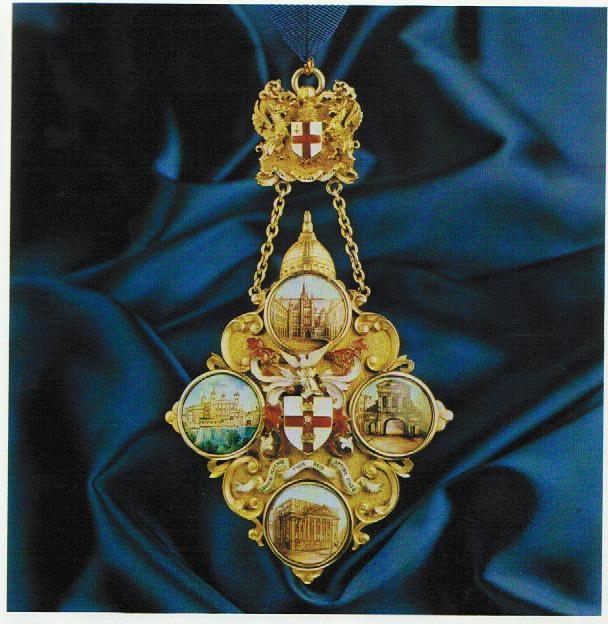
The Master's Badge is made of 9 carat gold and hallmarked London 1909 with the makers mark of W J Carroll and contains four hand painted miniatures.
- Top: Guildhall, a place of power in the City
- Left: The Tower of London, Palace and Fortress of the City
- Right: Temple Bar, Ceremonial entrance to the City, in the 18th Century. (The Corporation of London erected Temple Bar as a barrier to regulate trade into the City)
- Bottom: Mansion House, built after the Great Fire of London under the supervision of George Dance the Elder, a renowned architect, and the work was undertaken from 1739 to 1752 to provide a residence and hall for the Lord Mayor of London.
These Plaques are surmounted by the Dome of St Pauls carved in gold, and in the centre of the badge sits the arms of the Guild of Freemen, finely enamelled with our motto.
“ Londoni Defende Tous Deus Optime Cives"
“O Most Gracious Lord Defend Thy Citizens of London”
The plaques and arms are hung from a carved gold enamelled arms of the Corporation of London, celebrating a union of Power, Law, Arms and Governance of the City of London.
There is also an engraving on the reverse side of the badge that reads:
“Presented to the Guild of Freemen of the City of London by Cuthbert Wilkinson 1st Master of the Guild on January 28th, 1909 in the 9th Year of the Reign of King Edward VII (7th) and during the Mayoralty of Sir George Wyatt Truscott.”
A later silver gilt triple Chain was made for the badge in 1939 by Hicklenton & Phillips with two Corporation of London plaques that connect to the top plaque of the Master’s badge.
The Master’s Gown was designed for the Guild of Freemen by the academy winning costume designer Anthony Powell who won an Oscar for the film “Death on the Nile” and who also created costumes for Paul Newman, Steve McQueen, Bette Davis and Harrison Ford.
Deputy Master's Badge
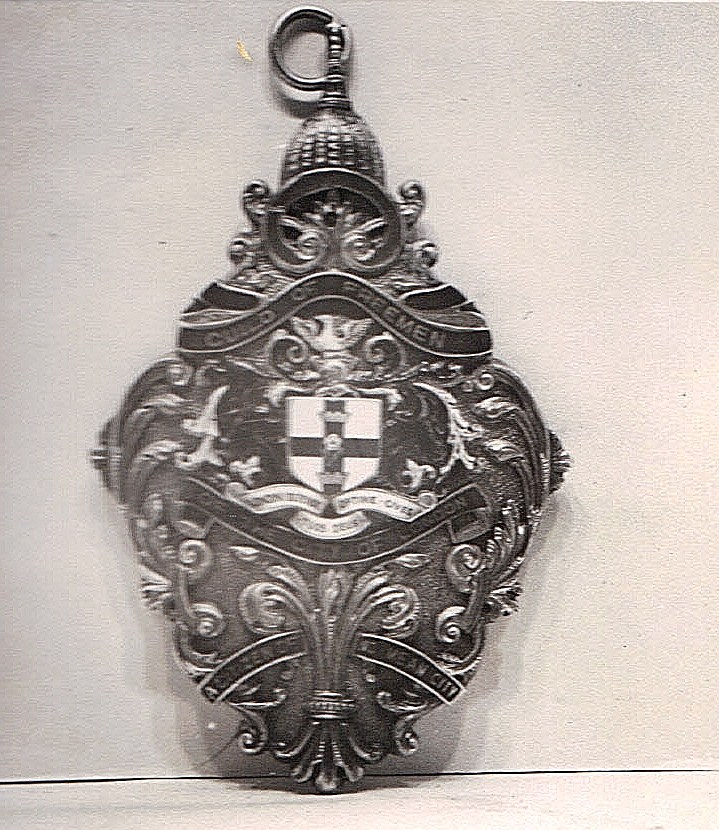
The Deputy Master or Under Warden’s Badge in silver gilt and enamel, of St Pauls Dome above the arms and motto of the Guild, presented by Harvey Brodie Self, founder member and first Deputy Master in 1909.
The Senior Warden's Badge would follow, cast in Silver Gilt and enamel, with the Corporation of London Arms above the arms and motto of the Guild, presented by Alfred Lockett, founder and first Senior Warden 1910.
The Renter Warden’s Badge that followed was made in the same form as the Senior Warden’s Badge in silver gilt and enamel, but with Renter Warden written instead of Senior Warden and presented by Henry Harrill, founder member and first Renter Warden in 1910.
The Junior Warden’s Badge is the same as the two preceding badges but with Renter Warden written instead and was presented by Alphonse Robert Hewitt, founder and first Junior Warden 1910.
There were two Past Master Badges created for the Past Masters of the Guild of Freemen, the first being the Elliott Sparks Badge made in silver gilt and enamel, by W J Carroll, the maker of the Master’s Badge and hallmarked London 1914. This Badge is now presented to the Immediate Past Master every year.
The Master and Wardens are responsible for the administration and activities of the Guild and form part of the Court of the Guild of Freemen who are accompanied by Assistants known as Court Assistants whose role compliments the running of the Guild’s affairs.
The Assistants wear a silver gilt enamel badge consisting of the Guild shield hung from the Corporation of London Crest on a silk ribbon.
None of the activities of the Guild would be possible without the enormous assistance of the Clerk of the Guild of Freemen and the current Clerk is Jeremy Cross, who assumed this role in 2021, the 10th Clerk since the Guild was founded.
The Clerk’s Badge is made of silver gilt and enamel and consists of two crossed quills set at the back of the Guild arms below the Corporation of London arms and is inscribed on the back:
“The Gift of Stanley J Willcox, a member of the Court of Assistants to
The Guild of Freemen of the City of London 1965”
One of the most utilised pieces of the treasures of the Guild of Freemen is
The Beadle’s Staff
The Beadle's Staff, which does take a battering from time to time, attends all important Guild events and was made by the Goldsmiths and Silversmiths Company and hallmarked London 1923. It consists of three parts, and when put together creates a staff 6 feet tall!
The head is made entirely of silver weighing a sturdy 45 ounces and is hand crafted with the Guild’s arms and motto and was it was presented to the Guild in the mastership of Sir John Lulham Pound by Sir Thomas Brooke-Hitching, Sheriff of London 1902-1903, and Master in 1911 in recognition of the kindness received at the hands of the Members of the Guild.
The Beadle now has a Badge too, made by Grant MacDonald of London in 2009 representing the Shield of the Guild encased in Silver and was presented to the Guild by Past Master Gordon Gentry.
The Loving Cups
The Guild of Freemen have accumulated over the last one hundred and twelve years a collection of 35 Loving Cups and for this article I have chosen to talk about four of the most interesting and unusual of them; I am sure that if I spoke about them all, we would run out of space!
The Ceremony of the Loving Cup goes back a thousand years to the time of Edward the Martyr who was slain by a dagger whilst drinking at Corfe Castle in the year of 978 and it was a ritual of toasting and drinking from a cup and cover that kept the right hand or the dagger hand in use, and the drinker’s back was guarded, so that no treachery by blade or poison took place.
The Victory Cup & Cover
Firstly, I would like to introduce to you to the Victory Cup, purchased by the Guild of Freemen on the 28th of June 1919, chosen by the Guild to commemorate the Victory of the Great War. It was made by the Royal Warrant holder, Elkington & Company, hallmarked London 1908 and weighs a hefty 105 troy ounces! It has a cast statuette of Victory on the cover. It is in fact the heaviest piece of silver in the Guild’s collection.
You may be wondering what is a troy ounce? A a troy ounce relates to the weight of precious metals and by 1527 became the official standard measurement for gold and silver in England. It was 10 % heavier than the normal avoirdupois ounce and was in use in the City of London to ensure that purity standards remained consistent within the City walls.
The Founders Cup
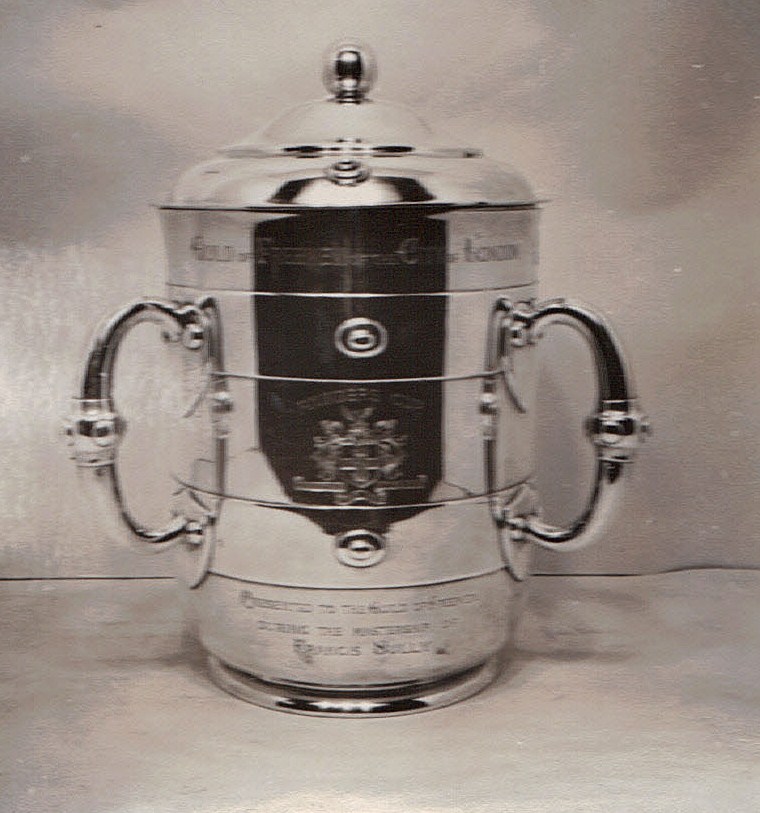
The Founders Cup was made by James Garrard, hallmarked London 1886 and weighs 52 troy ounces. James Garrard, a member of the Garrard family worked from 31 Panton Street off Piccadilly.
It is is engraved with
Guild of Freemen of the City of London Founders Cup
Presented to the Guild of Freemen during the Mastership of Francis Sully.
By the following Members who were Founders of the Guild
(here follows six names)
and in Affectionate Remembrance of Cuthbert Wilkinson, CC who was also a Founder and First Master.
The Livery Cup
One of the most prized pieces of the collection, this Loving Cup, known as the Livery Cup, was made by the famous silversmith Paul Storr in London in 1817 in the Reign of King George the III.
Paul Storr was one of the most celebrated silversmiths our country has ever known, and was renowned for his execution of presentation cups, notably the Nelson Cup, bestowed to Lord Horatio Nelson to mark the Victory at the Battle of the Nile in 1798.
The Livery Loving Cup is crafted in Paul Storr’s most well-known hand, a neo classical design of Roman origins, beautifully made, weighing an impressive 84 troy ounces, a real gem!
Paul Storr was apprenticed to Andrew Fogelberg, a Swedish Silversmith and obtained his Freedom of the City of London and became a Liveryman of the Worship Company of Goldsmiths in 1792, using his own hallmark, the following year, in 1793 and residing in premises at 30 Church Street in Soho.
In 1796 he moved to 20 Aire Street just off Piccadilly remaining there until 1807 where he moved back to Soho to Dean Street and formed a long-lasting relationship with Phillip Rundell of the family firm Rundell, Bridge & Rundell who held the Royal Warrant for George III, Soho being an area well known at this time for its proliferation of goldsmiths and silversmiths workshops.
It was in this workshop that Paul Storr created this wonderful Loving Cup. In 1819 he left Rundell and set up his own shop in at 17 Harrison Street off Grays Inn Road, finally moving again in 1822 to New Bond Street and partnering with John Mortimer to create Storr & Mortimer.
The origins of this Loving Cup are vague; however, we do know that an appeal for money to purchase this lovely piece, was raised by the Guild in 1921, but was insufficient to purchase it. A further appeal in 1937 provided satisfactory funds to acquire the Loving Cup, which must have been a sizeable sum indeed!
Other pieces from Storr’s workshop can be seen at Buckingham Palace and Windsor Castle as well as in the Wellington Collection at Apsley House.
The Blackham Cup
The Blackham Cup was made by Roberts and Brigge of London in 1864 weighing 52 troy ounces and was presented to the Guild by Colonel R J Blackhan in 1940 under the mastership of Thomas John McManis.
Colonel Blackhan was elected Junior Warden that year but declined the wardenship due to existing commitments with the War Effort and was promoted to Major General in 1941.WWII was a turbulent time for the Guild of Freemen and from 1940-1944 the Guild had the use of four different halls as headquarters, and the treasures were moved out of London to the Country for safekeeping.
Guild Premises
Since the inception, various rooms, offices, and hotels were used for formal meetings and events throughout the yearly calendar. Gresham College in Basinghall Street in the Ward of Bassishaw was used as early as 1913, and in 1915 the Guild moved on to De Keysers Royal Hotel at Blackfriars until 1918.
In 1919 the Guild moved on to Prince Henry’s Room at 17 Fleet Street, a well-known watering hole, and one of the few surviving buildings in the City of London dating from before the Great Fire of London.
In 1920 the Guild moved to the Cripplegate Institute on Golden Lane, a place of learning situated on the site of an Elizabethan Theatre and in 1921, the Guild moved again to Bakers' Hall in Harp Lane, where they shared the use of the offices, hall and court room until it was destroyed on the first night of the Blitz on December 29
th 1940, razing the hall to the ground and destroying many of the ledgers and record books. Fortunately, the plate in the strong room beneath the Hall was safe!
And then on again, from Bakers Hall to the Cordwainers Hall, destroyed by a bomb in April 1941, and on to Vintners' Hall for a year, eventually finding comfortable quarters at Tallow Chandlers Hall where the Guild retains a base today.
After being rebuilt after the Great Fire of London in 1672
Tallow Chandlers' Hall has remained virtually unchanged since the 17
th Century, however some damage was sustained during WWII including the original Oriel window. This window was restored in 1969 to a design by Carl Edwards incorporating the arms and shields of 19 Liveries and Guilds that were guests of the Tallow Chandlers’ Company, including our shield at the bottom centre. It also includes the Coat of Arms of King Edward IV in whose reign the Worshipful Company of Tallow Chandlers obtained their Charter of Incorporation in 1462, wherein the site of the Hall purchase would follow in 1476.
The Centenary Master’s Badge
From the early history of the Guild, we have arrived at the 100th Anniversary of the Guild of Freemen; and for the Centenary celebrations of 2008, Her Royal Highness the Princess Royal was approached with an invitation to become our Guild Centenary Master, the Princess Royal already having strong links with the Liveries of the City of London and officially completing her year as Master of the Worshipful Company of Woolmen.
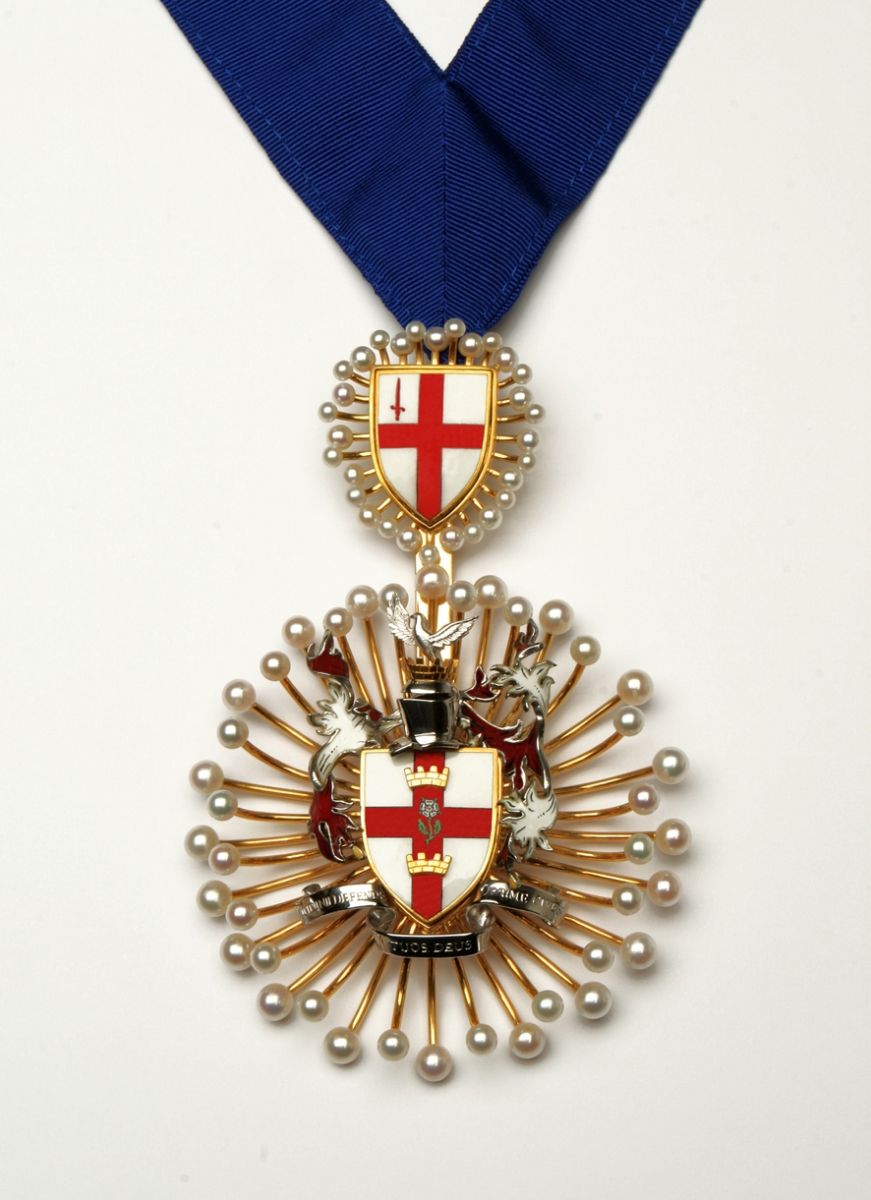
The Guild was delighted and honoured that her Royal Highness accepted the request. It created a logistical challenge in respect of the many formal meetings, working out schedules, timetables and of course security arrangements to enable the Guild to execute its annual program of events with a member of the Royal Family as the incoming Master of the Guild. For this year only an Assistant Master, Deputy Pauline Halliday, was appointed to support the Princess Royal’s timetable and oversee the Guilds official activities during this special year.
A special jewel was commissioned by the Guild for the Centenary Master and this was presented at her Royal Highness’s installation ceremony on the 28th of March 2008. We are very fortunate to be able to display this beautiful piece in this presentation.
This Centenary Badge was designed, and hand made by Grant Macdonald of London, maker, and holder of the Royal Warrant to the Prince of Wales and consists of a finely enamelled silver gilt pearl stone set jewel.
At the centre of the jewel is our coat of arms is finely enamelled in silver gilt, accompanied by saltwater pearls suspended on fine silver wires forming emanating rays. This is suspended from a Corporation of London shield, also with radiating pearls on smaller wires suspended from a royal blue ribbon.
The Jewel is inscribed on the reverse side:
“Presented to Her Royal Highness The Princess Royal Centenary Master
The Guild of Freemen 2008-2009.”
From the precious to the historical.
The Master’s Mallet
The Master’s Mallet consists of a wooden head and handle. The head is carved on one side with the Guild arms and the other side the arms of the City of London, with the Dunfee arms on the end. On the handle is a silver disk is engraved:
“Guild of Freemen City of London Colonel Vickers Dunfee Master 1926”
The head of the mallet is carved from one of the wooden torches of London Bridge circa 1215, and the handle of the mallet is made from an oak beam that formed part of the Roman embankment on the South side of the Thames for the City which was built around AD 99. Both pieces of wood were the gift of Oscar Berry, Master of the Guild for the following year in 1927.
Finally
Over the years the Guild of Freemen has maintained close associations with other organisations in other cities in Great Britain such as the Guilds of Coventry, York, and Chester from as far back as 1946, and the Honourable Company of Freemen of the City of London of North America, located in Toronto, of which member Paul Newall became Lord Mayor of the City of London in 1993 and was knighted the following year.
In addition to other Guilds, we have had ties to charities and benevolent funds such as HMS London, part of a heritage that has existed with the Royal Navy for over 70 years, with successive ships bearing the City’s name, and of course the longstanding link to the Royal National Lifeboat Institution particularly the RNLI station at Selsey, in West Sussex. The first City of London Lifeboat was sponsored by The Lord Mayor, the City Liveries and the Guild of Freemen of the City of London and was launched in 1984. Over the years the Guild is proud to have sponsored crew members and other members of RNLI Selsey Branch to receive the Freedom of the City of London for their lifesaving endeavours and fundraising activities.
The Guild of Freemen of the City of London has had a rich and fascinating past since 1908 and I am sure that we be able to continue this great legacy for many years to come.
Thank you for sharing this journey through history with me.
Sheldon Shapiro
If you are interested in learning more about the Guild history, there are two volumes of The History of the Guild are available to purchase via the
Merchandise area of this website.
